Bits and snaffle bits
Les mors les plus utilisés
Points to note before using mouthpieces
The good health of your horseís mouth
the bars must not be bruised,
over-teeth or flaws requiring the intervention of a dentist,
the shape of the roof might forbid you to use several bits with high port.
The good condition of the bit
Adapted to your horse's dressage level and physical ability (musculature and flexibility).
It brings nothing to ask him more than he can do.
Much humility from you
Did I have the correct hand action in accordance with the expected result ?
You have to choose the right size of bit :
Too narrow, it will pinch the mouth, create discomfort and even injure,
Too wide, its action will be imprecise. Two wrinkles have to appear at the corners of the mouth
Choosing the right size * (given in millimeters)

* Warning ! Each horse is different from the others and these informations are generalities which cannot suit all particular cases.
Choisir le matériau adapté à votre cheval
NICKEL PLATED
(N.P.)Generally speaking low quality but the rust can sometimes be relaxing. No FEELING bits in this quality.
STAINLESS STEEL
(S.S) The FEELING bits are made of very high quality (the best) 18 chrome stainless steel by using the 'LOST WAX SYSTEM' which ensures perfect polish and finish, as opposed to sand moulding that leaves defects. All the lots of FEELING bits are tested.
Quality bit guarantees security.
COPPER
(CUIV.) Relaxing through ions discharge that improves salivation.
GERMAN SILVER Alloy formulation with high copper percentage stimulating salivation, helping preventing dry mouthes and making your horseís relaxing easier.
CYPRIUM 90 High technology alloy containing 86 to 90 % copper (appreciated by horses and improving contact between your hands and your horseís mouth by activating salivation), 8 to 12 % aluminium and 3 % iron, guaranteed without nickel and zinc. The FEELING 'Cyprium' bits have a warmer feel and are better accepted than stainless steel ones. They have a very high stain resistance and are best quality bits.
BRASS
(LAI.) Only esthetic effect (matches yellow buckles).
FLEXI Stainless steel bits whose mouthpiece is covered with high technology synthetic material that is slightly perfumed with mint for a nice taste in the horseís mouth.
RUBBER Enables a stronger contact with horses which fear steel (or are allergic)
Jointed : Same action as stainless steel bits but milder.
Unjointed and stiff : You get a strong lean. This type of mouthpiece incites some horses to pull on the bit.
Unjointed and soft : Mild but strong contact. To use on young horses or horses which have a very sensitive mouth.
RESIN
(NATHE) Offers a very nice contact to the horse which comes nearly frankly on the bit. To be used on horses with sensitive mouth and which refuse contact with steel. No risk of allergy.
The different mouthpieces (a few examples)
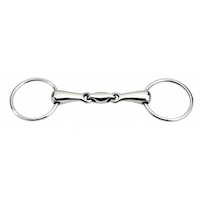
L Ring snaffle bits
Wide range of models and of possible effects. Bits with direct action on the lips with a light lift effect. Mullen mouthpieces are more severe than jointed and thin mouthpieces are "harder" than thick ones.
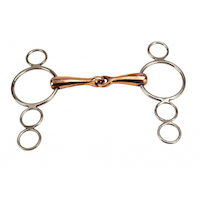
Continental gag bits
Continental Gag Bit, 3 and 4-Ring cheeks, helps elevate the horse's front and when the horse becomes heavy on the bit. The rings offer greater lateral control. The power of the action will depend on the thickness of the mouthpiece and on the position of the reins in the rings.
-Reins on the lowest ring : very strong leverage effect.
-With 4 reins (1 pair on the lowest ring and one on the central ring) : allows to vary the effects but requires a certain skillfulness.
-With a loop between low and central ring : the effect is intermediate but less precise. This adjustement suits well when you are not sure of your hand.

4-ring snaffles
4-Ring snaffle is made of a 2-Ring snaffle that fits, to moove freely, into 2 other rings on which cheek straps are fastened. This snaffle is quite relaxing as it mooves freely in the horse's mouth, but it becomes severe if the hand gets harder. Is also used very often in driving sport.
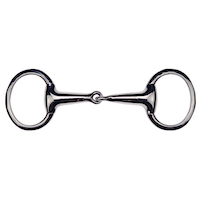
Eggbutt bits
Eggbutt Snaffle are very mild and cannot pinch the horse's lips. As the mouthpiece does not rotate around the ring, the action of the hand is quite direct.
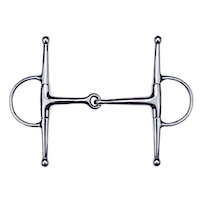
Full cheek bits
The full cheek bit has a simple action on the lips which is not different from ring snaffles or eggbut bits one. Its main feature is that it helps steering by giving more lateral control. It suits young horses not used to aids or adult horses presenting lacks of flexibility that need to be corrected. Full cheek snaffles should better be used with bit loops to keep cheeks upright
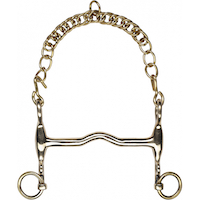
Weymouth bits
The Weymouth bit is quite exclusively used for dressage work. It brings a strong flexion through its leverage effect on the bars and the tongue. It is never used on it's own but always with a dressage bradoon (acting upwards on the lips). This combination of effects helps the rider to obtain a light and right collection. It requires therefore the use of 4 reins and a certain riding ability from the rider. Its action can be severe. The use of a lip strap prevents the horse from taking the cheeks with his lips
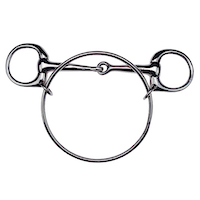
Racing bits
The bits that are used for racing are generally very severe. Their use is a matter from specialists.
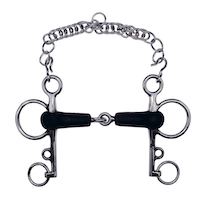
Pelham bits
A PELHAM bit has a strong leverage effect to flex the horse whilst taking
a big part of the impulse. It is used :
-with simple reins (very rare),
-with 4 reins and the required ability,
-with pelham roundings which allow to obtain an intermediary effect and reduces the severity of this bit that is always delivered with a curb chain.
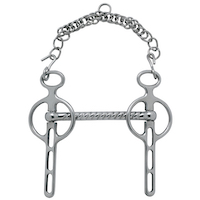
Liverpool bits
The Liverpool bits are exclusively used in driving sport where the only contacts are the hands and the voice. The rings bring lateral control and the cheeks make leverage to reinforce the action of the hands.
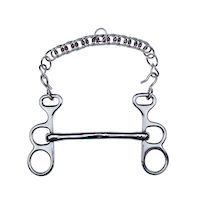
Gag bit
he Gag bit has a mullen mouthpiece, a curb chain, two rings on each side to fasten the driving reins. This bit is traditionnally more used with breastplate harnesses than with collar harnesses.
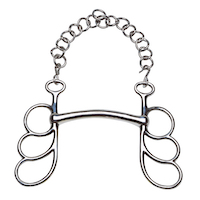
Driving butterfly bits
The Butterfly bit's conception is closed to the Gag Bit's one, but its effect can be more severe as it has an additive ring on each side. Like for all bits with curb chain that have a leverage effect, the lowest you fasten the reins, the strongest the action. This bit is traditionnally more used with a breastplate harness than with a collar harness.
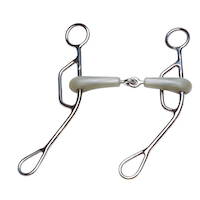
Training bits
The Training bits are coming from western riding but can also be used for traditional
European riding. The mouthpiece is not fixed to the rings and that allows the horse to play with the bit. They provide much leverage while also elevating the horse's front end. Only to be used by skilled riders on horses with much impulse.
Can be used : with one pair of reins attached to the shanks, with a lunge piece or with four reins.
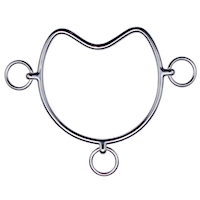
Chifney bits
A Chifney bit is used for stallions leading. It has a violent and direct action on the bars when the horse rears up.
Never to use by riding.
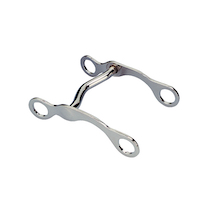
Western bits
The bits used "WESTERN" riding are extremely varied but they all have a very strong leverage effect and are therefore to use with care. The western riding is usually with "long reins" and the bit is only used by tension of the reins to restore the balance.
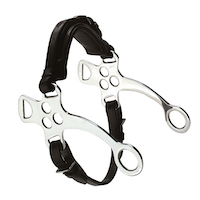
Hackamores
A Hackamore does not act on the horseís mouth as it has no mouthpiece but creates pressure just above the soft face of the nose.
The strength of the effect depends on two points :
-the width of the noseband : the thinest it is, the most severe it is.
-the length of the cheeks which increases the leverage effect.
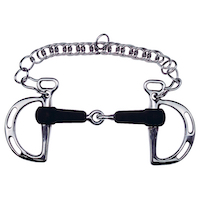
Kimberwick bits
The Kimberwick bit is used in Spanish riding as well as for jumping. Its action is quite strong as it is used with a curb chain and makes pressure on the bars with a leverage effect. It is mostly used on horses with much natural ´impulseª.
All Kimberwick bits are delivered with stainless steel curb chain and with hooks.
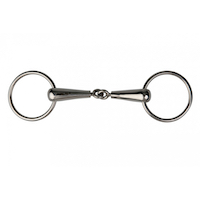
"Robart Pinchless" bits
(patent pending)
Riding : a tradition
In very few human activities does practice adhere to tradition more so than in Riding. Truly basic innovations in riding equipment are few and far between.
So it is with the bridle and harness bits.
Changes that have taken place over the ages reflect technological advances in Metallurgy on the one hand, and design changes to obtain more control over the usually unwilling horse on the other. The concept, however, has changed little, if at all. Obstinate horse - more severe bit, more obedient horse - less severe bit.
A revolutionary idea !
Along comes an inventive American horse trainer (David Robart) with a revolutionary idea and a bit design to implement it. Instead of training and working a horse on the basis of creating pain and the anticipation of pain, his bits will correct by pressure and will eliminate the pain, frequently unintentional, of pinched tongues and cheeks.
This desirable outcome results from a cleaver design feature. At crucial points on the bit - in the center of the mouthpiece on a jointed mouth bit and at the ends of the mouthpiece on straight mouth bits - there is an internal bushing which permits either half of the bit to rotate independently of the other.
Many advantages :
The benefits emanating from this are several :
- Working one rein will NOT cause either the entire bit to raise up and hit the palate, or to pinch the tongue as commonly happens with jointed mouth bits. Horsesí mouth remains closed and calm. Head tossing is all but eliminated.
- Either side of the horse can be worked separately. No confusion as to what the rider wants. The message is perfectly clear. The benefit of this clarity cannot be emphasized enough.
- Tension and stress in the horse is dramatically reduced. Horse can concentrate on learning and on performance, not on pain avoidance.